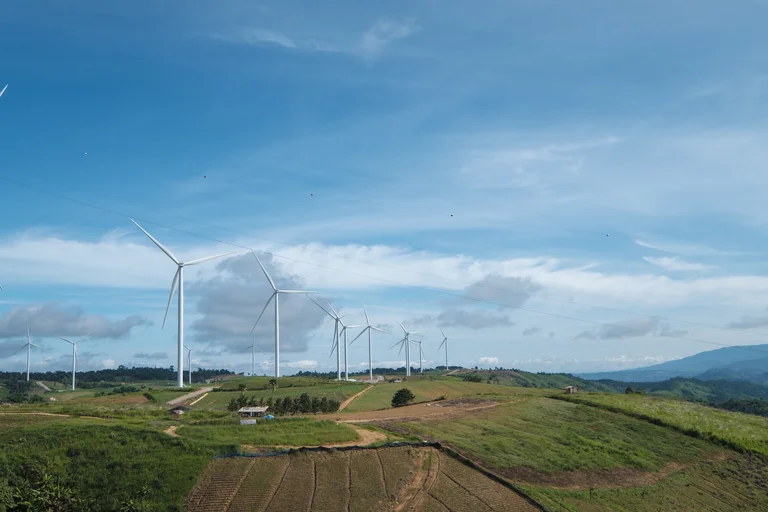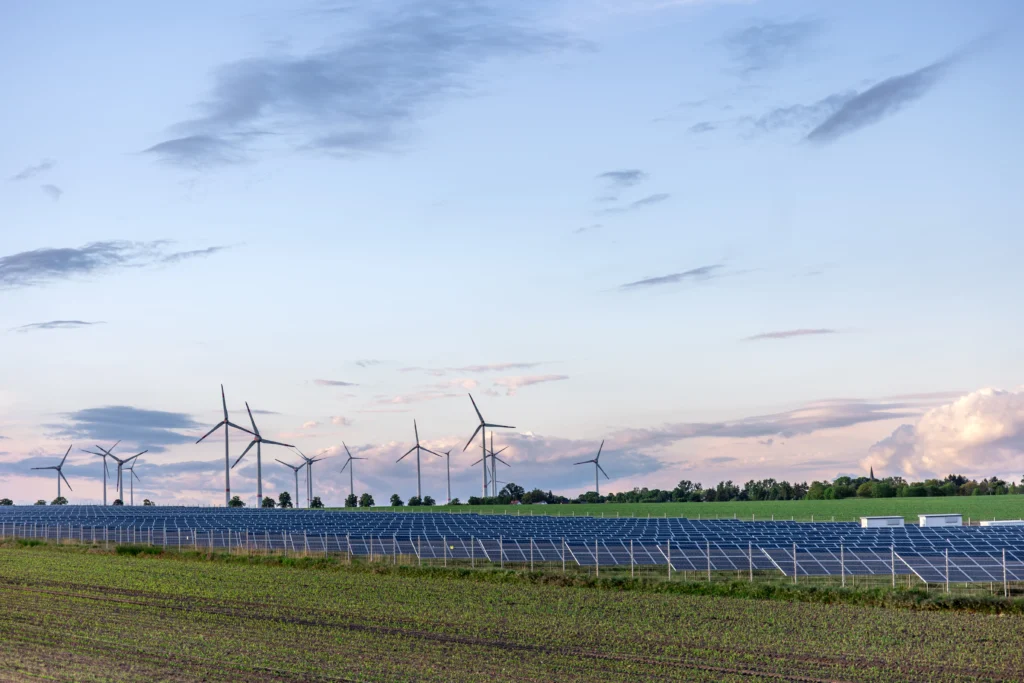Due to overproduction from rapid solar expansion, six major solar companies reported combined losses of RMB 20.2 billion (~US $2.8 billion) in the first half of 2025. In response, the government is enforcing regulations and considering state-backed consolidation.
Blog

China Growth Renewable Energy In 2025 As Climate Risks Intensify
China’s Renewable Energy 2025 is a turning point in the fight against climate change. As climate risks intensify, the country isn’t just adapting—it’s accelerating its transition to clean energy. Through bold policies, record-breaking investments, and leadership in both wind and solar energy, China is transforming its energy, industrial, and environmental systems, paving the way for a more sustainable future.
China Renewable Energy 2025: Record-Breaking Expansion:
China is aiming high with its 2025 goals, planning to get over one-third of its electricity from renewables. Already, wind and solar capacity are growing faster than new coal power plants, marking a major turning point in the country’s energy history.

1. China Renewable Energy Expansion in 2025:
Solar power continues to lead the charge in China’s Renewable energy race. In 2024, the country added more than 220 GW of solar capacity, pushing its total past 1,200 GW. Huge solar farms now span the deserts of Gansu and Inner Mongolia, transforming barren land into bustling energy hubs.
China’s push into clean energy has reached extraordinary levels:
. Renewable Capacity Surges: The country surpassed its 2030 targets six years ahead of schedule in 2024, installing more than 356 GW of new wind and solar capacity. Wind and solar power finally surpassed coal by early 2025, reaching over 1,400 GW.
. Rising Share of Clean Electricity: In April 2025, 26% of China’s electricity came from renewable sources, with solar accounting for 12.4% and wind for 13.6%. The first decrease in power sector emissions occurred in Q1 2025, when 36% of power generation came from renewable sources.
. Investments Fueling Growth: China made nearly US$940 billion in clean energy investments in 2024, comparable to significant global expenditures on fossil fuels.
. Emissions Decline: For the first time, power sector emissions fell in Q1 2025 as renewables hit 36% of generation.
2. Policies Powering China’s Renewable Energy Transition:
China’s green leap is underpinned by robust policy architecture:
. Industry Targets and Mandates: National and provincial rules increasingly require heavy industries and new high-demand facilities (like large data centers) to raise their 80% renewable share. These mandates help create guaranteed demand for clean electricity and link industrial policy to decarbonization goals.
. Energy system reforms and carbon pricing: China’s emissions trading scheme (ETS) has expanded beyond the power sector to include steel, cement, and aluminum, and post-expansion, it will cover roughly 60% of the country’s CO₂ emissions. This shift makes carbon pricing a meaningful driver for efficiency and clean-energy uptake across major industrial sectors
. Carbon Pricing Expansion: Today, industries like steel, aluminum, and cement are included in the Emissions Trading Scheme (ETS), which regulates almost 60% of China’s CO2 emissions.
. Sector-Specific Efficiency Plans: According to a Coal Decarbonization Retrofit Plan (2024–2027), coal plants must use technologies like carbon capture and cofiring with biofuels to reduce emissions by 50%.
3. Gigaprojects & Regional Innovation:
Ambitious projects and local initiatives underscore China’s commitment:
China is continuing to develop innovative strategies that combine solar energy with agriculture, alongside building massive solar parks, including in deserts and plateaus. These gigaprojects are key to rapidly expanding renewable capacity while also encouraging smart land use and boosting local economic activity. By integrating energy production with agriculture and other industries, China is paving the way for more sustainable and efficient land use.
Local innovation hubs and storage pilots:
Several provinces are testing out long-duration storage, flexible energy markets, green hydrogen projects, and green industrial parks. These initiatives are designed to manage the variability of renewable energy while also helping China develop and export valuable clean-tech expertise. China is establishing itself as a global clean-tech powerhouse and enhancing energy stability by taking the lead in these fields.
4. Global Leadership Amid Persisting Challenges:
China’s Renewable Energy carries global implications—but isn’t without contradictions:
Global Clean Energy Dominance:
A significant portion of China’s electricity still comes from coal, and the country continues to build new coal power plants. China was the world leader in new coal construction in 2024.
Grid Infrastructure & Storage Needs:
China must increase storage capacity, enhance grid flexibility, and extend transmission lines to boost the integration of renewable energy sources, especially given the ongoing challenges.
Why China’s renewable energy 2025 matters for global climate action:
China’s green shift sets a global climate dynamic—but also raises questions:
- COP30 and Global Climate Governance: China will play a crucial role in climate negotiations, particularly at COP30, as its leadership in clean energy continues to grow.
- Sustainable Innovation and Economic Synergy: China now has the political and financial capacity to further decarbonize—for instance, in smart grids, hydrogen, and long-duration storage—thanks to its economic gains from clean energy.
- Risks & Vulnerabilities: Climate change poses a threat to China’s electrical grid. By 2060, wind power availability may drop by up to 12% in some areas, necessitating flexible resilience investments.
Latest News & Developments (2025)
Here are the latest 2025 updates on China’s renewable energy—from record solar growth and falling emissions to new carbon market expansions.
Landmark Emissions Pledge:
According to BBC News report, In September 2025, China made a historic shift in its climate policy by setting its first-ever absolute emissions reduction target. President Xi Jinping announced at the United Nations that the country will cut economy-wide greenhouse gas emissions by 7–10% below peak levels by 2035. This pledge is important because, until now, China has relied mostly on intensity-based goals that measured emissions per unit of GDP. With this new promise, the country has moved toward a fixed ceiling, making its climate action more transparent and measurable.
Moreover, the pledge goes beyond carbon dioxide, covering all major greenhouse gases such as methane, nitrous oxide, and fluorinated gases. At the same time, China linked the announcement to other 2035 energy targets, including boosting wind and solar capacity to nearly 3,600 GW and increasing the share of non-fossil fuels in its energy mix to over 30%. These commitments highlight the growing alignment between climate goals, energy security, and industrial strategy.
However, experts have mixed views on the pledge. Some analysts believe the 7–10% reduction is conservative, as China’s existing policies may already achieve similar cuts. Others argue that the ambition falls short of what’s necessary to stay on track with the Paris Agreement’s 1.5°C pathway. Despite these debates, the announcement marks a turning point, signaling China’s shift from relative goals to absolute reductions in emissions.
Disclaimer:
China’s green transition is speeding up thanks to impressive innovation, clever policy frameworks, and record-breaking renewable deployment. Even though there are still issues with coal and overcapacity, the direction is clear: China wants to lead the world in climate change on its own terms by striking a balance between environmental responsibility, energy security, and economic growth.
FAQS
Q1. What is China’s renewable energy target for 2025?
Ans. China’s 2025 renewable energy target is to generate over one-third of its electricity from clean sources like solar and wind. The country plans to reach nearly 1,400 GW of combined solar and wind capacity by mid-2025, solidifying its position as a global leader in renewable energy growth.
Q2. How much of China’s electricity will come from renewables in 2025?
Ans. By April 2025, renewables supplied 26% of China’s electricity, with solar power accounting for 12.4% and wind at 13.6%. For the first time, renewable energy generation in China surpassed coal, marking a historic turning point in the country’s energy transition.
Q3. Why does China’s renewable energy growth matter globally?
Ans. China’s renewable energy growth matters because the country is the largest emitter of greenhouse gases. Its transition to clean energy directly influences global climate goals, drives down the costs of solar and wind technologies, and plays a pivotal role in shaping international climate negotiations, such as COP30.
Read more related article >https://www.climatechallange.com/breaking-news-cop28-unveils-bold-climate-action-agenda/
admin
0